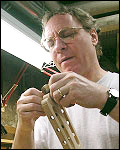2005
AL#82 p.38 BRB7 p.344
R.M. Mottola
 It’s not necessary to understand the physics of sound to be a great instrument maker, but it can’t hurt. Many of us would like to believe that we succeed using experience and strong intuition and don’t need science. Maybe an analytical mind just gets in the way, no? Or maybe the science guys are just smarter than the rest of us and we need an excuse not to stand in the same light that they do. Who knows? Anyhow, the Helmholtz resonance is the lowest vibratory mode of an instrument, though not necessarily the lowest note that instrument is capable of. All the rest of sound physics is built on top of the Helmholtz resonance, and Mottola devolves the science enough for the rest of us to understand. It’s fun but in the end it’s not clear that it really matters. For the few among us with operational math brains all the formulas are presented in a sidebar.
It’s not necessary to understand the physics of sound to be a great instrument maker, but it can’t hurt. Many of us would like to believe that we succeed using experience and strong intuition and don’t need science. Maybe an analytical mind just gets in the way, no? Or maybe the science guys are just smarter than the rest of us and we need an excuse not to stand in the same light that they do. Who knows? Anyhow, the Helmholtz resonance is the lowest vibratory mode of an instrument, though not necessarily the lowest note that instrument is capable of. All the rest of sound physics is built on top of the Helmholtz resonance, and Mottola devolves the science enough for the rest of us to understand. It’s fun but in the end it’s not clear that it really matters. For the few among us with operational math brains all the formulas are presented in a sidebar.
This article has been nominated as one of the Guild’s best articles published before 2010.


